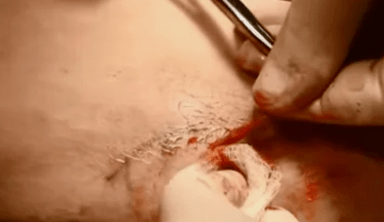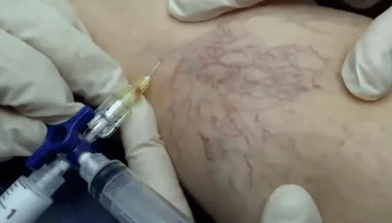Varicose veins or varicose veins, these expressions in phlebology mean pathology accompanied by changes, i.e. deformations of the veins.The blood vessels that carry blood to the heart dilate and lengthen, their walls become thinner, and the function of the vein valves is disrupted.
If the first stage of varicose veins is very effective in conservative treatment, then the disease progresses to the second and third stages and can only be cured by surgery; drugs and other methods can only prevent the progression of the pathology.This article will discuss the main surgical methods for treating varicose veins and their implementation characteristics.
Indications for surgery

Since surgical intervention is rarely performed due to lack of need during the first stages of varicose vein development, indications for surgery are a very important factor.The decision is based on data obtained during a detailed vascular diagnosis and is made by the patient together with his doctor.
The phlebologist is obliged to talk about the risks of the proposed surgery, the duration and nuances of post-operative recovery, and then only with the patient's consent.
In terms of indications themselves, varicose vein surgery is required in the following situations:
- Pathological dilatation and subsequent deformation of the pure saphenous vein of grade II and higher severity.
- A widespread form of varicose veins, a disease that affects not only the subcutaneous but primarily the deep veins, or deformations of blood vessels that spread over large areas of the lower limbs.
- There is a severe circulatory disorder with worsening blood stagnation.
- Severe swelling, high-intensity pain, and obvious external (aesthetic) signs of varicose veins.
- The formation of trophic ulcers or subcutaneous hematomas on the skin due to disruption of vascular integrity;
- The pathological process progresses until venous vessels are occluded and acute thrombophlebitis develops.
- There is a lack of aggressive motivation during conservative treatment, that is, when drugs and other methods of fighting varicose veins are ineffective.
Limitations and contraindications to surgery
Unfortunately, even in the presence of severe varicose veins, with complications and serious clinical manifestations, patients cannot always undergo surgery.
There are some contraindications that, even if the possibility of surgical intervention cannot be completely ruled out, still force the postponement of surgery for a period of time:
- Coronary heart disease – In this case, a more comprehensive comprehensive examination is needed.
- The same goes for grade 3 hypertension.
- Active infection and inflammatory processes in the body - Before having surgery to treat varicose veins, you need to deal with the infection or eliminate the inflammation.
- Second and third trimester of pregnancy - For pregnant women, it is best to postpone any surgical procedures until delivery.The only exception is when the life of the mother or child is in serious danger, surgery can help.
- Dermatology in the field of surgery to combat varicose veins.We’re talking about eczema, various forms of skin disease, and more.
- Of course, there are certain age restrictions, especially for the elderly.In some cases, advanced age and accompanying geriatric diseases can increase the risk of postoperative complications or threaten the lives of those on the operating table.
Surgical intervention methods for varicose veins
However, if the doctor is convinced that surgical intervention is required based on the diagnosis and examination of the patient, then all that remains is to choose the most appropriate and effective method based on the degree of progression of the varicose veins and many other factors.In order to understand what surgeries are available and under what circumstances they are performed, we will consider the most effective methods of surgical treatment of varicose veins.
combined phlebectomy

Comprehensive surgery is performed under general anesthesia and can last up to 2 hours, depending on the complexity of the task.Phlebectomy can be used to treat incipient forms of varicose veins, but this method is more commonly used in advanced cases when the disease has severely progressed.
During the surgery, the surgeon will make an incision up to 2 centimeters long if the surgery is on the ankle area or up to 5 centimeters if the surgery is on a larger area such as the groin.Typically these incisions are shallow because primarily superficial veins are removed.
The principle of surgery is to ligate the vascular anastomosis and then remove part of the vein affected by varicose veins.Additionally, during surgery, the surgeon can correct the vein valves to restore normal blood flow.
After the surgery is completed, cosmetic sutures are placed at the incision, a bandage is made, and an elastic bandage is tied to the surgical site to prevent bleeding.
venous resection
During this procedure, the affected area of veins is also removed, but the surgery is smaller and can be considered purely cosmetic.The idea is that the doctor makes a small puncture in the skin and pulls out the part of the vein that needs to be removed.The procedure is performed primarily on small blood vessels, and its advantages include being painless (due to local anesthesia) and minimal recovery time.
Sclerotherapy
This is a relatively new technique, a minimally invasive method known for its effectiveness and the absence of pain due to the same local anesthesia and an almost non-existent recovery period.

The procedure involves introducing a special substance into the lumen of the vein - a foaming sclerosant.This substance can cause the container walls to collapse during the subsequent bonding process.As a result, the veins cease to participate in the blood circulation process, gradually dissolve and are replaced by connective tissue.
Sclerotherapy techniques are primarily used to eliminate small superficial blood vessels and eliminate so-called "spider veins."
laser coagulation
Many experts believe that this is the most modern and effective way to combat varicose veins.Its essence is to insert a laser light guide tube into the venous lumen through a hole of only 2 mm.When the latter is activated, it starts emitting laser waves, the temperature inside the blood vessel increases, and when the laser is removed, the vein walls collapse and stick together.Later, the blood vessels disappear on their own and are replaced by connective tissue.
Of course, the main advantage of this procedure is that it causes almost no visible damage to the skin and requires no recovery period.
possible consequences
Even the gentlest of operations can leave some traces and possible consequences.First, this is due to the removal of an anatomical part of the body - a mature blood vessel.Of course, the consequences of a combined phlebectomy can be much more serious than a few bruises after laser coagulation.
Let's consider the most basic consequences that occur regularly after surgical treatment of one kind or another:
- When varicose veins are eliminated using minimally invasive methods that exclude vessel resection, there is a risk of recurrence.This risk during laser coagulation is minimal, only 5%.
- Burns – Occur after procedures using thermal effects.
- Bleeding - can begin after any type of intervention, but is more likely to occur after phlebectomy.
- There are also known cases of nerve damage, but this factor is only related to the expertise of the surgeon.
recovery process
Each of the above cases requires rehabilitation, that is, recovery after surgery, but if after coagulation this process takes only a few days, then after combined phlebectomy it can last several weeks.To ensure a smooth and fast recovery, it's important to follow simple advice:
- Follow all your doctor's recommendations strictly.
- Wear a compression garment or elastic bandage.
- If there are incisions, it is important to wait for them to heal.
- After the incision has healed, it is important to resume physical activity; exercise therapy and regular walking will help with this.
- If your doctor has prescribed any medications, take them as directed.
- Seeing a massage therapist after surgery can also help prevent varicose veins.
- You should not engage in strenuous physical activity for at least 2-3 months.
If the surgery goes well and the patient fully adheres to all of the doctor's instructions regarding recovery, the likelihood of a good outcome is very high.In most cases, varicose veins are treatable, but that doesn't mean the disease doesn't affect other blood vessels.Therefore, varicose vein prevention should always be done if a case of varicose veins occurs.























